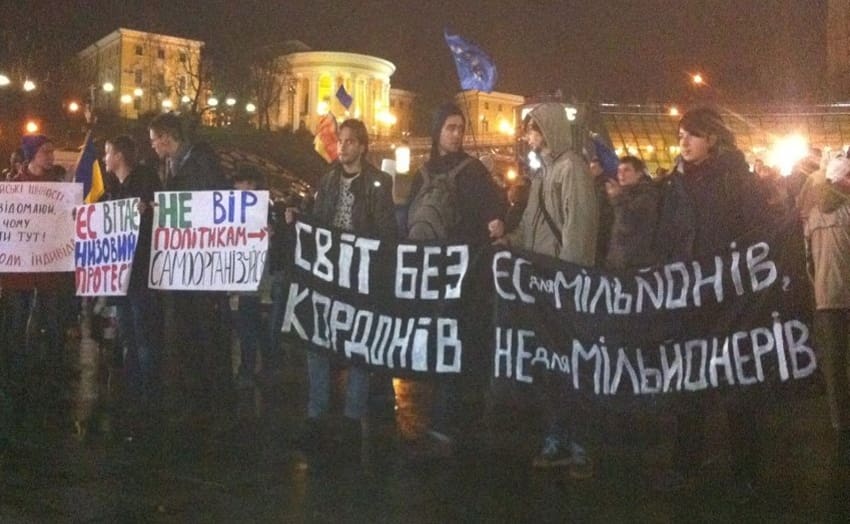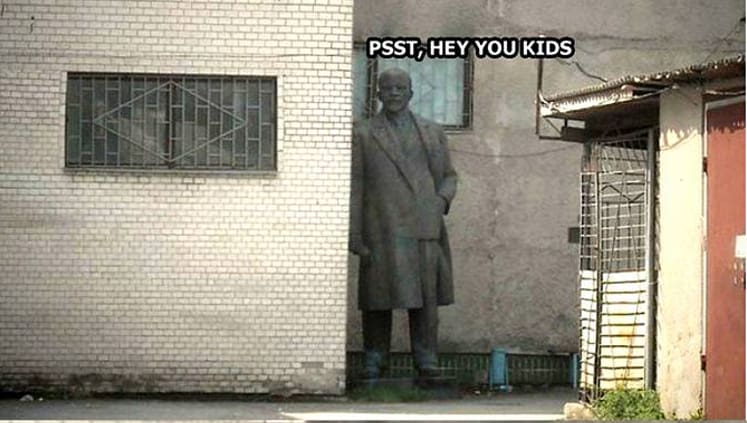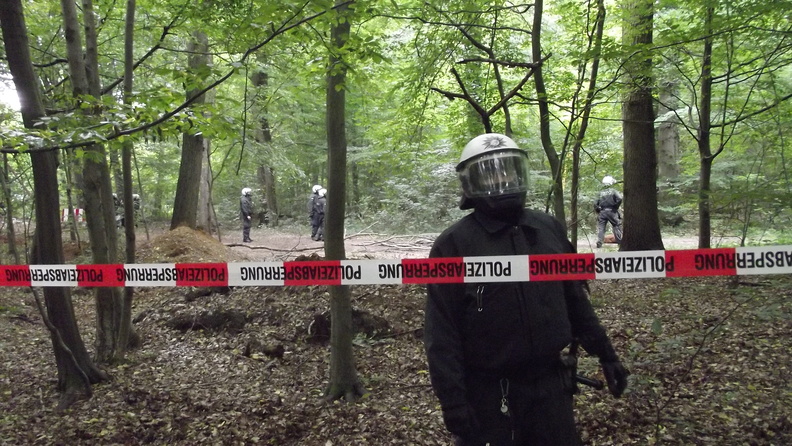Transcribed from the 27 October 2018 episode of This is Hell! Radio (Chicago) and printed with permission. Edited for space and readability. Listen to the whole interview:
Migration is not illegal. Seeking asylum is not illegal. Nothing that the migrant caravan is doing is illegal.
Chuck Mertz: The Trump administration’s policy of separating migrant children from their families at the US border, forcing them into tent cities, is inhumane. But the problem is, those tent cities started not under Trump but Obama, as his administration and the Democratic Party tried to show that they too could be tough on immigration, just like the Republicans. It’s not the first time the Democrats have turned their backs on a potential new base in immigrants, and apparently it won’t be the last, as Dems who support the Abolish ICE movement, even winning elections on the stance, are starting to back away from the position.
Under Trump, “Abolish ICE” is the newest campaign for immigrant rights meant to stop deportations, a campaign that started during the Obama administration when the Democrats were building Trump’s deportation machine. Here to tell us what #AbolishICE is all about, journalist Tina Vasquez wrote the Rewire.News article “Abolish ICE: Beyond a Slogan.”
Welcome back to This is Hell!, Tina.
Tina Vasquez: Hi, thanks for having me.
CM: Before we get to your article on abolishing ICE, I know you’ve written a little about the migrant caravan, so first of all let me ask you a bit about that. Why does the phrase “migrant caravan” stick in my throat? Why does it sound like there’s something wrong with that phrase? Is it somehow depicting the migrants in a certain way that is misleading?
TV: That’s something that I’ve been struggling with also, and asking a lot of people about. On social media, a lot of undocumented people and immigrants in the US are saying that we should simply refer to these folks as asylum-seekers, which they are. That is the most accurate way to describe the migrant caravan. But also, people who I’ve spoken to on the ground, for example a Honduran transgender woman who’s in touch with other transgender women who are part of the caravan, told me that the language used on the ground among asylum-seekers in the caravan is “caravan.” They refer to themselves as the migrant caravan.
Given that context, I’ve been using the term migrant caravan in my reporting, but if you want to be most technical and specific, they are asylum-seekers, period.
CM: There are reports that another so-called caravan is building up at the Guatemalan border which may take the same route as the current one. Laura Weiss posted an article at the North American Congress on Latin America’s website, where she writes, “Violence in Honduras has intensified since 2009, when the country ousted its democratically elected president, Manuel Zelaya, with the tacit support of the United States, in a coup. The rightwing presidents who have followed have pushed neoliberal economic agendas that have worsened conditions for the working poor, reducing opportunities to make a living at home.
“[Salva] La Cruz, a coordinator with the Fray Matias human rights center in Tapachula, Chiapas, noted that the instability has increased the flows of migrants passing through southern Mexico. These factors, exacerbated by US ‘help,’ are what is driving immigration from Honduras.”
How much is US policy in Central America and throughout Latin America causing the migrant caravan? Is the US making life impossible for Hondurans and Guatemalans in their home countries, and then when they flee to the US for refuge, they are turned away and sent back to their abusive governments that the US supports?
TV: The United States definitely has a lot of blame in the situation for many of the migrants coming to the US. There was a very similar situation in the 1980s, when people from El Salvador were coming to the United States to seek asylum because the US contributed to their country’s destabilization by backing death squads and dictators. There is an entire history of US foreign policy making certain countries uninhabitable for the people who live there; those people migrate to the United States to seek asylum—fleeing for their lives because of the violence in their countries of origin—and what the United States does, despite being partly responsible for their migration, is criminalize those migrants.
We’ve seen this cycle play out over and over again, and that’s exactly what’s happening with the asylum-seekers who are part of the migrant caravan now. Honduras was, until very recently, the murder capital of the world—just extreme violence and militarization. This isn’t only coming from gang violence in these countries. It is also their own governments and their increasing militarization that is very harmful—especially to women, trans people, children, the most vulnerable populations—so they migrate to the United States.
It’s important to note that migration is not illegal. Seeking asylum is not illegal. Nothing that the migrant caravan is doing is illegal. Many of them will present themselves at a port of entry at the US-Mexico border to seek asylum, and that is in accordance with US and international asylum law. Nothing that they’re doing is illegal, but we see every step of this being criminalized, especially under the Trump administration.
CM: So we’re criminalizing them, we’re saying they’re national security threats, and we’re making life impossible for them in their home countries. To what extent is there a love/hate relationship among migrants with the US—that is, they hate what US policy has done to their own country, and how US policy labels them, but they still view the US as a place of refuge?
TV: For the folks I’ve spoken to, it’s a very complicated relationship. I spoke to a woman who is in touch with folks in the migrant caravan, and she said that those folks want their American Dream, but they are very aware of the conditions that they are facing when they get to the US. It’s also important to note that all these things that the Trump administration and other administrations have done to “deter” people from migrating—none of it works. Because they are fleeing for their lives.
When family separation policy was enacted, the number of people migrating to seek asylum was on the rise. There is no correlation between harsh and inhumane policies meant to “deter” migrants and whether or not they will actually migrate. That’s a risk they are willing to take because they are running for their lives, and they still strongly believe that they can build a better life for themselves and their families in the United States, and as long as people are living in conditions where their children are in harm’s way, where they face violence, where they may lose their family members or their own lives, they’re going to continue migrating to the US.
The United States never really addresses why people migrate. They attempt to criminalize the migration, never looking at the conditions that have forced people to leave their countries.
CM: You also wrote an article on LGBTQ people traveling with the migrant caravan. What are the unique challenges LGBTQ people face in their home countries, during their trek to the US, and finally at the US border?
TV: They take a lot of abuse. The number of LGBTQ people in general, and trans women in particular, has skyrocketed. Trans women in particular are facing a lot of violence, a lot of abuse, they are being murdered and disappeared in increasingly brutal ways. The reports that I receive indicate that they face additional barriers when they try to migrate. At the Guatemalan border they were being turned away. They were being abused by officials, being called names. Many face sexual assault, harassment, and things of that nature while they migrate.
Both parties have been more than willing to militarize the border and target certain immigrant communities, and everybody could sort of agree that deportations and increased border enforcement was okay. When president Obama announced DACA, he also announced that there would be a huge uptick in what they call “border security,” which just means the further militarization of the border.
With the migrant caravan that we saw earlier this year, there was another contingent of transgender women who were migrating, and they couldn’t find a shelter to stay at. The shelter that did open its doors to LGBTQ migrants ended up getting burned down. The trans women who I spoke to understand that wherever they go they will be subjected to abuse, because that is the nature of transphobia. But they are still hopeful that in the United States they will have rights and safety that they don’t have in their countries of origin.
CM: Let’s get to your writing on the #AbolishICE movement. You write, “Back in 2013, Marisa Franco was working with the National Day Laborer Organizing Network (NDLON) as the campaign director of #Not1More, a movement that demanded president Obama stop deportations. The campaign, which had the backing of immigrant rights organizations nationwide, was also a response to the unlawful and racist ways that the then-Maricopa county sheriff Joe Arpaio was terrorizing immigrant communities in Arizona.”
To you, what explains why Democrats would tolerate deportations during the Obama administration but not tolerate the current Trump policy? Is this simply because the Trump policy is even more inhumane than the Obama administration’s policy was? Did it finally just “go too far”?
TV: That’s a good question. It’s something that I struggle with as a journalist, trying to figure out how to report on it. As we discussed the last time I was on, much of what we’re seeing under Trump was made possible under Obama. But because with president Obama it wasn’t tied to overt racism and overt inhumane acts and overt anti-immigrant sentiment, people were willing to let it slide. Both parties have been more than willing to militarize the border and target certain immigrant communities, and everybody could sort of agree that deportations and increased border enforcement was okay. That enforcement piece actually came along with Deferred Action for Childhood Arrivals (DACA). When president Obama announced that, he also announced that there would be a huge uptick in what they call “border security,” which just means the further militarization of the border.
All of that was okay with Obama. I don’t recall any Democrats speaking out against his immigration policies. A lot of Trump’s promises on the campaign trail were for things that were already happening under the Obama administration, but they were simply now tied to racism and anti-immigrant sentiment. Then he was elected and we saw these really egregious, inhumane policies roll out. I think that’s the line in the sand for a lot of people. But for many years, immigrant communities have been subjected to these kinds of detentions and deportations and inhumane policies, and Democrats were pretty silent on it.
CM: You write, “In the early days of the Trump administration, the mainstream discussion was focused on what would happen to the Dreamers after Trump announced he was ending DACA. But [Marisa] Franco, the #Not1More campaign director, knew the Trump administration would wield Obama’s immigration machinery in harsher, more unprecedented ways. She saw the threat coming.”
Then you quote Marisa Franco saying, “I was out for three months last year when I had a baby, and the few times I called the staff I remember yelling, ‘Sound the alarm! Dreamers now means all immigrants, and border enforcement is code for enforcement en total.’”
How does ending DACA lead to Trump separating immigrant kids from their families?
TV: So much focus was on DACA—these kids’ stories are very compelling. And no matter where you fall on immigration, there’s a lot of empathy for young people who came to the United States and essentially identify as American since they’ve been here since they were two or three, and who have no recourse, who want to go to college. There are a lot of “model minority” stereotypes tied in with the DACA recipients, at least in the media.
But while there was so much focus on what would happen to the most “palatable” immigrant group, the Trump administration was doing all of this stuff very quietly behind the scenes. We learned that the family separation policy at the border was confirmed by Jeff Sessions in April 2018—but it was first rolled out in July of 2017. Families were being ripped apart at the border, but so much of the public narrative was around what to do about DACA, what to do to save these kids.
Under the Obama administration it was so much more broad. The question was what to do to get a pathway to citizenship for eleven million undocumented people currently in the US. Under Trump, that just narrowed and narrowed until it included only a few hundred thousand DACA recipients.
CM: You write, “The federal agency under the umbrella of the Department of Homeland Security (DHS) that is mainly responsible for carrying out deportations is of course Immigration and Customs Enforcement, or ICE. [Marisa] Franco is now the executive director of the social justice organizing network Mijente. It was during a Mijente staff meeting two years ago, prior to the election of Donald Trump, that the organization began to discuss what abolishing ICE might mean.”
Does not having ICE, or an ICE-like group, mean that we would have no border security, that anyone could enter the United States? Can there be border security without ICE? That’s how those on the right are framing the idea of abolishing ICE: that it’s a radical and absurd idea because suddenly we’ll have a wave of criminals and terrorists entering the US.
Does abolishing ICE mean abolishing any and all border security?
TV: I don’t believe so. ICE is very specific. Marisa told me that the reason why they chose to focus on ICE and not the Department of Homeland Security—which encompasses ICE, Customs and Border Protection, and Border Patrol—is because ICE specifically carries out detaining and deporting people. We would still have border enforcement, because Customs and Border Protection and Border Patrol are the agencies that carry out enforcement at the border. That would still be in place.
Right now, if I’m understanding correctly, the movement to abolish ICE is mostly trying to gather support and get people thinking about what it could look like to chip away. I don’t think there is a set plan for removing other federal immigration agencies. Right now the focus is ICE. There would still be border enforcement; the border would still be militarized; there would still be those vetting systems in place. And even just dismantling ICE will be very slow. They know this isn’t going to happen overnight. The folks who I spoke to are really in it for the long haul, understanding that this could take years and years to do.
CM: You write, “Both the Obama and Trump administrations have detained asylum-seeking families in record numbers, overwhelming both the detention centers and the Office of Refugee Resettlement, the federal immigration agency responsible for detaining migrants who are under the age of eighteen. Though the full impact of Trump’s policies is not yet known, both Trump and Obama have also placed children in tent cities, and while the Trump administration is reported to be considering detaining children on military bases, the Obama administration beat him to it.”
How much is ICE the consistent factor from Obama to Trump? Is all this more an outcome of administration policy or the infrastructure that ICE enforces within that policy? How much is immigration policy driven by ICE no matter which president or party is in office?
ICE essentially operates as a rogue agency. It’s very hard to hold them accountable. Their spending has been called into question by members of congress, but ultimately they’re given more money.
TV: Those two things are very tied up. Under every administration, congress throws more and more money at ICE, which allows them to operate increasingly independently and without much oversight. ICE essentially operates as a rogue agency. It’s very hard to hold them accountable. Their spending has been called into question by members of congress, but ultimately they’re given more money.
It’s really about the framing from each administration. President Obama used a lot of the same talking points that Trump does about targeting criminals, but when you look at the actual apprehensions, they are simply people who are in the United States without authorization. Now Trump is calling those people criminals.
With both administrations there has been a conflation in the language—conflation of immigration and violence, or immigration and terrorism. This is par for the course when it comes from ICE, and it makes sense if you think about how ICE formed (it’s not exactly a radical idea to envision a world without ICE, because ICE has only been around since 2003 and it came about with the formation of the Department of Homeland Security after 9/11). Since ICE’s inception, there has been this conflation of immigration and terrorism.
With each administration giving ICE more money, more power, more independent oversight over how these things are carries out, you can’t really separate the two. It’s both an ICE problem and an administration problem, because no administration has really done the hard work of looking at ICE’s practices. Individual ICE agents actually have a lot of discretion. Trump signed his executive orders on immigration, but that didn’t require ICE to apprehend every undocumented person they encounter. That is something that individual ICE agents are choosing to do. With the uptick in anti-immigrant rhetoric and a largely anti-immigrant administration, ICE follows suit and behaves more recklessly in immigrant communities.
So it does depend on the administration, but also, ICE has been given so much money and so little oversight that this is simply how ICE operates now.
CM: You write, “When Mijente’s Chinga La Migra tour launched, Franco said Democrats gave the organization the side-eye, perhaps thinking the seemingly fringe campaign would do little to help them create a blue wave in the November midterm elections.”
Do you think it would be good for the Democratic Party to embrace abolishing ICE, in terms of getting votes in November’s election? I’m not asking if they should on moral grounds, but only when it comes to being a good political strategy for attracting more voters in November. Should the Democrats embrace #AbolishICE?
TV: It’s hard to say. A lot of people think of abolishing ICE as a really radical idea. There are three Democrats who have proposed an #AbolishICE bill with the ultimate goal of shutting down ICE and investigating ICE agents to see if they’ve violated people’s rights or flouted international law…and it seems like Republicans are already using that as a way to shine a light on those Democrats and say how radical that they are, and split the party, because there are Democrats that certainly do think that’s radical.
It’s hard to say how that would play out. Under Trump in particular, people who maybe had no feelings on immigration before are really emboldened now and disgusted by the way the immigration system operates. My fear is that this is being tied to the Trump administration in particular as opposed to the system as a whole, and the understanding that the US immigration system is inhumane. But I don’t know really how that will play out in an election.
I don’t know if people really think that the country is ready to abolish ICE, if they think that’s too radical. Any Democrat who gets behind the movement is taking a risk, and on the other hand impacted people working toward abolishing ICE are very wary of any involvement from elected officials, because they don’t want them to co-opt the message and turn the movement into something that suits them and their party or their platform and not immigrants in the United States.
CM: I know this is a really general question, but you make a really important point about this—what’s wrong with linking immigration to national security?
TV: It sets up the system to ‘other’ immigrants. It’s really easy to put systems in place that criminalize them, that subject them to extreme levels of vetting. It’s trading the idea of American security for criminalizing immigrant communities. When that in particular is applied to the border or to asylum-seekers, we see how unwieldy it becomes.
The Trump administration is somehow implying that there may be terrorists in the migrant caravan. That kind of rhetoric gets picked up by the American public and gets tied to immigrants. It’s just another way of criminalizing people who want to come to the United States, with no proof at all. The Trump administration can just make these accusations of terrorism, that they are rapists, that they are drug dealers—they just use this rhetoric without any proof, even though there are bodies of evidence showing that communities are safer when undocumented immigrants aren’t being criminalized and they feel safe interacting with law enforcement.
There is no real reason to conflate immigration with terrorism. National security, of course, is important, but focusing on immigration in the conversation of national security as opposed to the uptick in domestic terrorism or white supremacist movements that we’re seeing—none of that will ever be addressed as long as we focus on immigration and criminalizing immigrants, with no real evidence that they are threatening our national security but lots of evidence that they actually improve living conditions for American citizens.
CM: You write, “A perfect example of such triangulation when it comes to immigration policy is when president Obama rolled out the DACA program in 2012, which coincided with the announcement that the administration was ‘putting more boots on the southern border than at any time in our history.’ Obama also sought to ‘centralize border security’ on the pretext of deporting violent criminals and gang members, and brought back the prison-like conditions in family detention centers in response to the number of asylum-seekers fleeing gang violence in Central America. This was the same category of parents and children that the Trump administration separated at the border and may soon be able to detain together indefinitely.”
To what degree is it possible to maintain a humane immigration policy while simultaneously keeping conservatives and Republicans happy? Is that possible? Can we actually have bipartisanship lead to humane immigration policy?
TV: I don’t think that we are at a point in our nation’s history where that is possible. The Trump administration has really brought something out in the Republican party. They actually used to be relatively friendly on immigration, if we look at what Reagan said, what Bush Sr. said. Those were fairly immigrant-friendly administrations. But seeing what the party is now, I don’t think the two parties can agree on what a humane immigration system is. Under the Trump administration, the goal appears to be to deport everyone who is in the United States without authorization, and not only that, to stop the ability of black and brown people specifically to migrate to the United States. If that is the bottom line, if that’s the talking point, if that’s the thing that all the rhetoric leads to, I don’t think the two parties could ever agree on what “humane” looks like.
CM: Tina, I really appreciate you coming back on our show. Thank you so much.
TV: Thank you so much for having me.
Featured image: meme based on a courtroom conversation between prosecutor and defendant in one of the 2019 criminal cases resulting from state targeting of humanitarian organization No More Deaths for their decades of work alleviating border lethality





